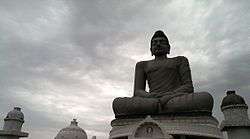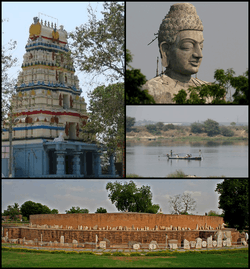Amaravathi (village), Guntur district
| Amaravathi అమరావతి Amravati, Amareswaram | |
|---|---|
| Village | |
|
Amareswara temple, Buddha statue, An overview of Krishna river, Mahachaitya | |
 Amaravathi  Amaravathi Location in Andhra Pradesh, India | |
| Coordinates: 16°34′23″N 80°21′29″E / 16.573°N 80.358°ECoordinates: 16°34′23″N 80°21′29″E / 16.573°N 80.358°E | |
| Country | India |
| State | Andhra Pradesh |
| District | Guntur |
| Mandal | Amaravati |
| Area[1] | |
| • Total | 11.70 km2 (4.52 sq mi) |
| Elevation[2] | 38 m (125 ft) |
| Population (2011)[3] | |
| • Total | 16,000[4] |
| Languages | |
| • Official | Telugu |
| Time zone | IST (UTC+5:30) |
| PIN | 522 020 |
| Telephone code | +91–8645 |
| Vehicle registration | AP–7 |
Amaravathi is a village in Guntur district of the Indian state of Andhra Pradesh. It is located in Amaravati mandal of Guntur revenue division, on the banks of Krishna river.[1][5] Amaravati, the new capital of Andhra Pradesh was named after this historic village and is also a part of Andhra Pradesh Capital Region.[6]
Although now it is officially designated as a village administered by a gram panchayat,[7] it is an important historic town, and served as the capital of the Satavahana kingdom in ancient days.[8] Sri Amaralingeswara Swamy temple is located at the Amararama Pancharama Kshetra site in this village, which makes it a holy town for the Hindus. It is also a historic Buddhist site, and the Amaravati Mahachaitya stupa was built here between the 2nd century BCE and the 3rd century CE.[9][10] Designated as a historic site by the Government of India, Amaravati has been chosen as one of the sites for Heritage City Development and Augmentation Yojana (HRIDAY) scheme of Government of India.[11]
Etymology
Amaravathi translates to The town which lives on forever in the local language.[12] It is also referred as Amareswaram, for its famous Amareswara temple dedicated to Lord Siva, one of the famous Pancharamas.[13] It was formerly known as Andhra Nagari.[14]
History
The recorded history of Amaravati and nearby Dharanikota dates to 5th century BCE. It was the capital of Satavahanas who ruled from 3rd century BCE to 3rd century CE. After the decline of Satavahanas, Andhra Ikshvakus and later Pallava kings ruled Krishna river valley. Subsequently, Eastern Chalukyas and Telugu Cholas held sway over the region. Kota Kings were in control of Amaravati during the medieval times. Kota kings were subdued by Kakatiyas in 11th century CE and Amaravati became part of the unified Telugu empire. The Skanda Purana gives a picture of the place and the Siva temple located here.[15]
Amaravati was part of Delhi Sultanate, Musunuri Nayaks, Bahmani Sultanate, Vijayanagara Empire, Sultanate of Golconda and Mughal Empire successively before the founding of the Nizam of Hyderabad in 1724. It was ceded to France in 1750 but was captured by England in 1759. Guntur returned to the Nizamate in 1768 but was ceded to England again in 1788. It was briefly occupied by Hyder Ali. It was part of Madras Presidency during the British colonial period.
The stūpa or mahācaitya
The most important historic monument in Amaravathi village is the Mahachaitya. It is protected by the Archaeological Survey of India which maintains a site museum beside the ruins.
Geography
The city is located at 16°34′N 80°22′E / 16.567°N 80.367°E[16] on the south bank of Krishna river.
Demographics
As of 2011 Census of India, the town had a population of 13,400 with 3,316 households. The total population constitute, 6,432 males and 6,958 females —a sex ratio of 1,082 females per 1,000 males. 1,321 children are in the age group of 0–6 years, of which 647 are boys and 674 are girls —a ratio of 1,042 per 1,000. The average literacy rate stands at 71.34% with 8,617 literates, higher than the state average of 67.41%.[3][17]
Culture


The town is a centre of pilgrimage to both Hindus and Buddhists. The inscriptions on the walls of the Amareswara temple depicts the reign of Vasireddy Venkatadri Nayudu who ruled before the advent of the British rule. He was well known for his benevolence, munificence and for the construction of a large number of temples and education centres in the Krishna river delta.[18] It also hosts 125 ft tallest Buddhist statue in India.[19] The ancient structures and replicas can be found at Kalachakra museum, renamed as Amaravati Heritage Centre and Museum.[20]
The people speak Telugu. The common traditional clothing for women is a Saree and for men a Panche or a Lungi and Uttariyam. The town was given a hagiographic portrayal in the famous short story series Amaravati Kathalu by Satyam Sankaramanchi. The stories describe the contemporary culture of local people during the reign of Vasireddy Venkatadri Nayudu and also post-independent times.
The main Hindu festivals celebrated are Mahasivaratri and the Navaratri. The 30th Kalachakra festival, a popular Buddhist ritual was held at Amaravati in the first week of January 2006. It is the home for the oldest tourist places for Buddhists.[21]
Transport

Amaravati has road connectivity and no rail network. Vijayawada–Amaravati Road connects the village with city of Vijayawada, Andhra Pradesh capital city areas of Undavalli, Penumaka, Rayapudi.[22] While, the Guntur–Amaravathi Road connects it with the district headquarters, Guntur.[23] It also has road connectivity from Sattenapalle, Mangalagiri and Krosuru. APSRTC operates buses from major bus stations like, NTR bus station of Guntur and Pandit Nehru bus station of Vijayawada.[23][24][25] The village has no rail connectivity.
A waterway categorised as class–III is planned from Pulichintala to Prakasam Barrage, which connects the nearby villages of Harishchandrapuram and Vykuntapuram.[26]
Education
The town plays a major role in education for the rural students of the nearby villages.The primary and secondary school education is imparted by government, aided and private schools, under the School Education Department of the state.[27] As per the school information report for the academic year 2015–16, the town has more than 3,543 students enrolled in over 16 schools.[28][29]
See also
References
- 1 2 "District Census Handbook – Guntur" (PDF). Census of India. p. 14,252. Retrieved 18 January 2015.
- ↑ "Elevation for Amaravati". Veloroutes. Retrieved 31 July 2014.
- 1 2 "Census 2011". The Registrar General & Census Commissioner, India. Retrieved 25 July 2014.
- ↑ "Introducing Andhra Pradesh's new capital Amaravathi".
- ↑ "List of Villages in Guntur District" (PDF). VGTM Urban Development Authority. Retrieved 22 October 2015.
- ↑ "After 18 centuries, Amaravati set to become a 'capital' again". The Times of India. 22 October 2015.
- ↑ CFMIS Data Entry Status of Gram Panchayats in Amaravathi Mandal of Guntur District
- ↑ ":::- WELCOME TO GUNTUR DISTRICT OFFICIAL WEBSITE -:::".
- ↑ "Buddha – Amaravati".
- ↑ "Forget the Kohinoor, could we have the Amaravati Stupa sculptures back please?".
- ↑ "Introduction". HRIDAY official website.
- ↑ "Andhra Pradesh's capital city Amaravathi". Deccan Chronicle. Hyderabad. 6 April 2015. Retrieved 18 April 2015.
- ↑ "Other name of Amaravati". Guntur district website. Retrieved 31 July 2014.
- ↑ "Amaravati Museum". AP Tourism Department. Retrieved 31 July 2014.
- ↑ Skanda Purana In: Puranic Encyclopedia, 1975, Vettam Mani, Motilal Banarsidas, New Delhi
- ↑ "redirect to /world/IN/02/Amaravati.html". fallingrain.com.
- ↑ "Literacy of AP (Census 2011)" (PDF). Official Portal of Andhra Pradesh Government. p. 43. Archived from the original (PDF) on 14 July 2014. Retrieved 5 September 2014.
- ↑ Sri Raja Vasireddy Venkatadri Nayudu, 1973, K. Lakshminarayana, Ponnuru <http://www.openlibrary.org/details/rajavasireddyven022548mbp>
- ↑ "Tallest Dhyana Buddha to be ready in Amaravati".
- ↑ Varma, P. Sujatha (25 July 2016). "Kalachakra Museum regains lost sheenKalachakra Museum regains lost sheen". The Hindu. Retrieved 23 September 2016.
- ↑ "India forgot Buddha for 1,000 years: Sircar". The Times of India.
- ↑ "Four lane road to Andhra Pradesh new capital soon".
- 1 2 Srinivas, Rajulapudi (25 October 2013). "25 passengers rescued from stranded APSRTC bus in Narsaraopet". The Hindu. Guntur. Retrieved 8 March 2016.
- ↑ "RTC to introduce bus services in Guntur city". Deccan Chronicle. 26 November 2014. Retrieved 4 June 2016.
- ↑ "Bus services to Amaravathi from Guntur".
- ↑ "River Route Planned for Amaravati". The New Indian Express. 26 November 2015. Retrieved 4 June 2016.
- ↑ "School Education Department" (PDF). School Education Department, Government of Andhra Pradesh. Retrieved 7 November 2016.
- ↑ "School Information Report".
- ↑ "Student Information Report". Commissionerate of School Education. Child info 2015-16, District School Education - Andhra Pradesh. Retrieved 10 November 2016.
External links
| Wikimedia Commons has media related to Amaravati. |
